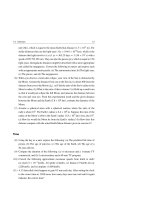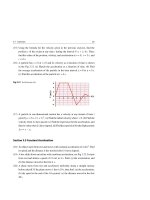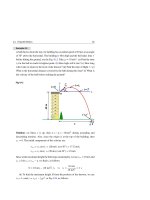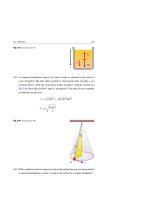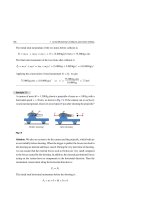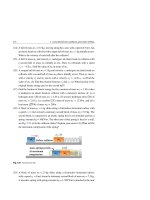Hafez a radi, john o rasmussen auth principles of physics for scientists and engineers 28
Bạn đang xem bản rút gọn của tài liệu. Xem và tải ngay bản đầy đủ của tài liệu tại đây (484.67 KB, 20 trang )
21.1 Electric Flux
703
A
Area A
A
θ
θ
E
Area A
E
Side view
→
Fig. 21.3 The definition of a vector area A whose magnitude represents the surface area and whose
direction is defined to be perpendicular to the surface area
Generally, the electric field may vary over the surface of any shape. Let us consider
the general surface depicted by the shape in Fig. 21.4 and calculate the electric flux
over the whole surface.
dA
θ
E
→
Fig. 21.4 The differential surface vector area d A of magnitude dA and direction perpendicular to the
→
differential surface area and pointing outwards. When the electric field E makes an angle θ with that
→
→
differential surface area, the differential flux d E is E • d A
→
We start by considering a differential vector surface area dA to be normal to the
surface and to point outwards at a specific location. If the electric field vector at this
→
location is E , then the differential electric flux d E through this differential area
will be:
→
d
E
→
= E • dA
(21.4)
We integrate this relation over a surface S to get the electric flux as:
E
→
=
→
E • dA
S
Generally,
E
depends on the field pattern and the surface shape.
(21.5)
704
21 Gauss’s Law
→
According to the definition of the vector area dA which always points outwards,
→
→
the sign of the flux depends on the angle between E and dA as follows:
→
(1) If θ < 90◦ , then E crosses the surface from the inside to the outside and hence
→
→
d E = E • dA is positive.
→
→
→
(2) If θ = 90◦ , then E grazes the surface and hence d E = E • dA is zero.
→
(3) If 90◦ < θ < 180◦ , then E crosses the surface from the outside to the inside
and hence d
→
→
E
= E • dA is negative.
The net flux through a surface is proportional to the net number of electric field
lines leaving the surface. If more lines are entering than leaving, then the net flux is
negative. If more lines are leaving than entering, then the net flux is positive.
We can write the net flux through a closed surface as:
E
where the symbol
=
→
→
E • dA
(21.6)
represents an integral over a closed surface.
Example 21.1
Find the electric flux through a sphere of radius r enclosing at its center: (a) a
positive charge q, and (b) a negative charge −q.
Solution: (a) When a positive charge q is at the center of such a sphere, the electric
field would be directed outwards and be normal to the surface. It would also have
a constant magnitude, E = q/(4π ◦ r 2 ), see Fig. 21.5. Therefore:
→
→
E • dA = E dA cos 0◦ = E dA =
q
4π
◦r
2
dA
Fig. 21.5
dA
E
E
r
+ q
21.1 Electric Flux
705
From Eq. 21.6 and the fact that
dA over a spherical surface gives the area of the
sphere, i.e. dA = A = 4π r 2 , we find the net flux through the sphere that encloses
the positive charge q to be:
E
→
→
=
E • dA =
q
4π
◦
r2
dA =
q
4π
r2
◦
4π r 2 =
q
◦
(b) When a negative charge −q is at the center of such a sphere, the electric
field would be directed inwards and be normal to the surface. It would also have
a constant magnitude, E = q/(4π ◦ r 2 ), see Fig. 21.6. Therefore:
→
→
E • dA = E dA cos 180◦ = −E dA = −
q
4π
◦r
2
dA
r
Fig. 21.6
E
r
dA
r
E
r
-
−q
Performing similar steps as in part (a), we find the net flux to be:
E
=
→
→
E • dA = −
q
4π
◦
r2
dA = −
q
4π
◦
r2
4π r 2 = −
q
◦
Negative electric flux means electric lines are entering the surface.
21.2
Gauss’s Law
In this section, we introduce a new foundation of Coulomb’s law, called Gauss’s
law. This law can be used to take advantage of symmetry in the problem under consideration. Central to Gauss’s law is a hypothetical closed surface called a Gaussian
surface.
In Example 21.1 we noticed that the flux over a sphere of radius r was equal to the
charge q inside the sphere divided by the permittivity of free space ◦ . Now consider
several closed Gaussian surfaces surrounding the charge as shown in Fig. 21.7. The
706
21 Gauss’s Law
number of electric field lines passing through the spherical surface S1 is the same as
the number of lines passing through the non-spherical surfaces S2 and S3 . Therefore,
we conclude that the flux through any closed Gaussian surface surrounding the point
charge q is q/ ◦ .
Fig. 21.7 Different closed
Gaussian surfaces enclosing a
point charge q. The net electric
flux is the same through all
q
surfaces
S1
S2
S3
+
E
Gauss’s law is a generalization to what we just described.
Gauss’s Law
The net electric flux through any closed surface is equal to the net charge inside
the surface divided by the permittivity of free space ◦ .
That is:
E
=
→
→
E • dA =
qin
(21.7)
◦
→
where qin represents the net charge inside the surface and E represents the total
electric field at any point on the surface, which includes contributions from charges
inside and/or outside (if any).
Note that Gauss’s law is very useful in calculating electric fields in situations where
the charge distributions have planar, cylindrical, or spherical symmetry. In these
charge distribution systems, one must carefully construct the imaginary Gaussian
surface such that it simplifies the integral in Eq. 21.7. This can be done by trying to
satisfy one or more of the following conditions:
(1) The value of the field over the surface is constant, E = constant.
→
→
→
→
(2) The dot product E • dA is E dA because E // dA .
→
→
→
→
(3) The dot product E • dA is zero because E ⊥ dA .
(4) The value of the field over the surface is zero, E = 0.
21.3 Applications of Gauss’s Law
21.3
707
Applications of Gauss’s Law
Example 21.2
Using Gauss’s law, find the electric field at a distance r from a positive point
charge q, and compare it with Coulomb’s law.
Solution: We apply Gauss’s law to the spherical Gaussian surface of radius r
in Fig. 21.5. From the symmetry of the problem, we know that at any point, the
→
electric field E is perpendicular to the surface and directed outwards from the
→
→
→
→
spherical center. Thus, E // dA and E • dA = E dA. Then, with qin = q, we can
write Gauss’s law as:
E
=
→
→
E • dA =
This leads to:
qin
◦
⇒
→
→
E • dA =
E=
1
4π
E dA = E
dA = 4π r 2 E =
q
◦
q
q
=k 2
2
r
r
◦
which is simply Coulomb’s law. This proves that Gauss’s law and Coulomb’s law
are equivalent.
Example 21.3
Prove that any excess positive charge q on the isolated conductor of Fig. 21.8 will
lie entirely on its outer surface.
Gaussian
surfaces
Conductor's
outer surface
Conductor's
inner surface
Cavity
Fig. 21.8
708
21 Gauss’s Law
Solution: The electric field inside the conductor must be zero. If this is not the
case, the field would exert forces on the free electrons and a current would flow
within the conductor. Of course, there are no such currents in an isolated conductor
in electrostatic equilibrium.
First, we draw a Gaussian surface surrounding the conductor’s cavity, close to
→
its surface, as seen in Fig. 21.8. Since E = 0 inside the conductor, then E = 0
and hence according to Gauss’s law, no net charge would exist on the inner walls
of the cavity.
Then we draw a Gaussian surface just inside the outer surface of the conductor.
→
Since E = 0 inside the conductor, then E = 0 and according to Gauss’s law, no
net charge will exist inside the Gaussian surface. If the excess charge is not inside
the Gaussian surface, it must then be outside that surface, on the conductor’s
surface; see Fig. 21.9.
Fig. 21.9
+
q
Conductor's
outer surface
+
+
Conductor's
inner surface
+
+
+
Cavity
Example 21.4
Using Gauss’s law, find the electric field just outside the surface of a conductor
carrying a positive surface charge density σ.
Solution: Consider a small section of the conductor’s surface so as to neglect
curvature. Then construct a cylindrical Gaussian surface normal to the conductor
as shown in Fig. 21.10, where one end of the cylinder is inside the conductor while
→
the other end is outside. Each end has an area A. The electric field E inside the
→
conductor is zero, and the electric field E just outside the conductor’s surface
21.3 Applications of Gauss’s Law
709
must be perpendicular to the surface. If this were not true, the component of the
field along the surface of the conductor would force the free electrons to move,
violating the conductor’s electrostatic equilibrium.
E =0 +
+
A
+
+
+
+
+
E =0 +
+
+
+
+
Conductor
E
Gaussian
Charge per cylinder
Side view
unit area σ
A
E
σ
Fig. 21.10
To find the net flux through this cylindrical Gaussian surface, let us consider
→
each of the four faces of the cylinder. (1) Because E = 0 inside the conductor, then
the flux through the end of the cylinder inside the conductor is E (1) = 0. (2) For
the same reason, the flux through the curved surface of the cylinder inside the con→
→
ductor is E (2) = 0. (3) Since E ⊥ dA along the curved surface of the cylinder
→
→
outside the conductor, the flux there is also E (3) = 0. (4) Since E // dA along
the end of the cylinder that is outside the conductor, the flux there is E (4) = EA.
Thus, the net flux through the cylindrical Gaussian surface is E = EA. Since
qin = σ A, we can then find electric field just outside the surface of the conductor
as follows:
E
=
→
→
E • dA =
qin
◦
⇒
EA =
σA
◦
⇒
E=
σ
◦
Example 21.5
Find the electric field due to an infinite plane sheet of charge with a uniform
positive surface charge density σ.
→
Solution: By symmetry, the electric field E outside the infinite plane sheet must
be: (1) uniform, (2) perpendicular to the sheet, (3) of the same magnitude at all
points equidistant from the sheet, and (4) in opposite direction on the other side
of the sheet, see Fig. 21.11. The choice that reflects that symmetry is a cylindrical
710
21 Gauss’s Law
Gaussian surface normal to the sheet as shown in Fig. 21.11, where one end of
the cylinder (of area A) is to the right of the sheet while the other end is to the left
of it.
+
+
+
+
+
+
Sheet of charge
+
+
A
A
+
E
E
E
+
+
Charge per
unit area σ
+
A
E
+
+
+
A
Gaussian
cylinder
Side view
σ
Fig. 21.11
As in Example 21.4, to find the net flux through this cylindrical Gaussian
→
→
surface, let us consider each of the four faces of the cylinder. (1) Because E // dA
through the left end of the cylinder, then the flux there is E (1) = EA. (2) Because
→
E ⊥ dA through the left curved surface of the cylinder then the flux there is
→
→
E (2) = 0.
→
(3) For the same reason (E ⊥ dA ), and the flux through the right
→
→
curved surface of the cylinder is E (3) = 0. (4) Because E // dA through the
right end of the cylinder, then the flux there is E (4) = EA. Thus, the net flux
through the Gaussian surface is E = 2EA. Since qin = σ A, we then can find
electric field as follows:
E
=
→
→
E • dA =
qin
◦
⇒
2 EA =
σA
◦
⇒
E=
σ
2 ◦
Example 21.6
Two infinite conducting plates have a uniform surface charge density of magnitude
σ on their faces. The excess charge is positive on one plate and negative on the
other, see Fig. 7.12a, b. The two plates are brought together as shown in Fig. 21.12c.
Find the electric field to the left and right of the plates in each part of the figure.
Solution: The charge on the positively charged conductor in Fig. 21.21a will
spread over its two faces each with a surface density of magnitude σ . From
21.3 Applications of Gauss’s Law
711
Example 21.4, the electric field just outside each of these surfaces would be
directed away from the two faces and would have a magnitude of:
E+ =
Conductor
σ′
+ +
+ +
(a)
◦
Conductor
Conductor
- - - -
+ +
E+
σ
E+
σ′
E−
σ′
(b)
E−
E =0
σ′
+
+
+
+
+
+
σ = 2σ ′
E
Conductor
-
E =0
(c)
Fig. 21.12
We have a similar situation in Fig. 21.12b, except that the electric field is directed
toward the two faces and has a magnitude given by:
E− =
σ
◦
When we bring the two plates together, the excess charge on one plate attracts
the excess of charge on the other, and all the excess charge moves onto the inner
surfaces of the plates, see Fig. 21.12c. The magnitude of the new surface charge
density of the inner surfaces is σ = 2σ . Thus, the electric field between the plates
is to the right with a magnitude:
E=
σ
◦
(Between the plates)
The electric field on the outer sides of the two plates of Fig. 21.12c is zero since
no charge is left on those sides.
Example 21.7
Two infinitely long nonconductive sheets are aligned in parallel, see Fig. 21.13a.
Each sheet has a fixed uniform charge. One sheet is positively charged and has
a surface charge density of magnitude σ+ = 6.5 µC/m2 . The other sheet is negatively charged with |σ− | = 4.5 µC/m2 . Find the electric field: (a) to the left (L) of
the sheets, (b) between (B) the sheets, and (c) to the right (R) of the sheets.
712
21 Gauss’s Law
σ+
L
+
+
+
+
+
+
B
-
σ−
σ+
E+
E−
R
L
(a)
+
+
+
+
+
+
E+
E−
B
(b)
-
σ−
E+
σ+
EL
E−
R
L
+
+
+
+
+
+
EB
B
-
σ−
ER
R
(c)
Fig. 21.13
Solution: For items of fixed charge, we can calculate the electric field of the
items in the same manner as if each item were isolated, i.e. by adding the fields
algebraically using the superposition principle. Thus, the magnitude of the electric
field due to the positive sheet is:
E+ =
σ+
6.5 × 10−6 C/m2
= 3.67 × 105 N/C
=
2 ◦
2(8.85 × 10−12 C2 /N.m2 )
Also, the magnitude of the electric field due to the negative sheet is:
E− =
σ−
4.5 × 10−6 C/m2
= 2.54 × 105 N/C
=
2 ◦
2(8.85 × 10−12 C2 /N.m2 )
The directions of the fields to the left (L), between (B), and right (R) of the sheets
are shown in Fig. 21.13b. The resultant field depends on the values of E+ and E− .
Since E+ > E− , then EL is:
EL = E+ − E− = 3.67 × 105 N/C − 2.54 × 105 N/C = 1.13 × 105 N/C (to the left)
The field to the right of the sheets ER has the same magnitude but is directed to
the right. Between the sheets, we have:
EB = E+ + E− = 3.67 × 105 N/C + 2.54 × 105 N/C = 6.21 × 105 N/C (to the right)
Example 21.8
Using Gauss’s law, find the electric field at a distance r from a long thin rod that
has a uniform charge per unit length λ.
Solution: By symmetry, the electric fields outside the rod are radial and lie in
a plane perpendicular to the rod. Additionally, the field has the same magnitude
21.3 Applications of Gauss’s Law
713
at all points at the same radial distance from the rod. This suggests that we can
construct a cylindrical Gaussian surface of an arbitrary radius r and height . Such
a cylinder would have its ends perpendicular to the rod as shown in Fig. 21.14.
+
+
+ r
Gaussian
cylinder
Top view
dA
+
r
E
E
+
+
Fig. 21.14
We divide the flux into two cases: (1) The flux through the two ends of the Gaussian
→
→
→
cylinder is zero because E is parallel to these surfaces, i.e. E ⊥ A . (2) The flux
through the curved surface of the Gaussian cylinder can be obtained by taking into
→
→
→
→
account that E = constant and E is parallel to dA , i.e. E • dA = E dA. Therefore,
→
→
E • dA = E dA = E dA = EA, where A is the area of the curved cylinder
and is given by A = 2π r . The net charge inside the Gaussian cylinder is qin = λ .
We can now use Gauss’s law to find the electric field as follows:
E
=
→
→
E • dA =
qin
◦
⇒
→
→
E • dA =
E dA = E
= E(2π r ) =
Then:
E=
1
2π
dA
λ
◦
λ
λ
= 2k
r
◦ r
This relation was derived in Chap. 20 using Coulomb’s law (Eq. 20.36).
Example 21.9
A solid sphere of radius R has a uniform volume charge density ρ and carries a
total positive charge Q. Find and sketch the electric field at any distance r away
from the sphere’s center.
714
21 Gauss’s Law
Solution: We divide the solution to 0 ≤ r ≤ R and r ≥ R.
(1) For 0 ≤ r ≤ R
When dealing with a spherically symmetric charge distribution, we chose a spherical Gaussian surface of radius r < R concentric with the charged sphere as shown
in Fig. 21.15.
Fig. 21.15
ρ
R
dA
r
E
Gaussian
sphere
By symmetry, the magnitude of the electric field is constant everywhere on the
→
→
spherical Gaussian surface and normal to the surface at any point, i.e. E // dA .
Thus:
→
→
E • dA =
E dA = E
dA = E(4π r 2 )
It is important to notice that the volume, say V , of the Gaussian sphere encloses
a net charge qin = ρV ; that is:
qin = ρV = ρ( 43 π r 3 )
We can now use Gauss’s law to find electric field as follows:
E
=
→
→
E • dA =
E=
Then:
qin
◦
ρ
r
3 ◦
⇒
E(4π r 2 ) =
ρ( 43 π r 3 )
◦
(0 ≤ r ≤ R)
Using the definition ρ = Q/( 43 π R3 ) and k = 1/(4π ◦ ), we get:
E=
Q
4π
◦
R3
r=k
Q
r
R3
(0 ≤ r ≤ R)
21.3 Applications of Gauss’s Law
715
(2) For r ≥ R
Again, because the charge distribution is spherically symmetric, we can construct
a Gaussian sphere of radius r > R concentric with the charged sphere, as shown
in Fig. 21.16.
Fig. 21.16
Q
dA
R
Gaussian
sphere
→
E
r
→
Just as when r < R, E • dA = E(4π r 2 ), but qin = Q. Thus, we can use
Gauss’s law to find the electric field as follows:
E
i.e.:
=
→
→
E • dA =
E=
1
4π
qin
⇒
◦
Q
Q
=k 2
2
r
◦r
E(4π r 2 ) =
Q
◦
(r ≥ R)
Notice that this is identical to the result obtained for a point charge. Therefore, we
conclude that the electric field outside any uniformly charged sphere is equivalent
to that of a point charge located at the center of the sphere. At r = R, the two cases
give identical results E = kQ/R2 . A plot of E versus r is shown in Fig. 21.17. This
figure shows the continuation of E and its maximum at r = R.
Fig. 21.17
ρ
R
E=k
E
Q
r2
Q
E=k 3r
R
0
R
r
716
21 Gauss’s Law
Example 21.10
A thin spherical shell of radius R has a total positive charge Q distributed uniformly
over its surface. Find the electric field inside and outside the shell.
Solution: By symmetry, if any field exists inside the shell, it must be radial. Let us
construct a spherical Gaussian surface of radius r < R concentric with the shell,
see the cross sectional view in Fig. 21.18.
Fig. 21.18
+
Q
+
R
Gaussian
sphere
+
Spherical +
shell
+
r
+
+
+
Based on Gauss’s law, the lack of charge inside the surface indicates that
→
→
E • dA = E(4π r 2 ) = 0, or E = 0. Accordingly, we conclude that there is no
electric field inside a uniformly charged spherical shell.
Outside the shell, we construct a spherical Gaussian surface of radius r > R
concentric with the charged shell as shown in Fig. 21.19.
Fig. 21.19
Q
+
+
r
+
Spherical
shell
Gaussian
sphere
+
R
+
+
→
+
+
→
Symmetry suggests that E = constant on that surface and E is parallel to dA ,
→
→
i.e. E • dA = E(4π r 2 ). Since the net charge qin inside the Gaussian surface is
equal to the total charge Q on the shell, the shell is equivalent to a point charge
located at the center. That is:
E=
1
4π
Q
Q
=k 2
2
r
◦r
(r > R).
21.4 Conductors in Electrostatic Equilibrium
21.4
717
Conductors in Electrostatic Equilibrium
Conductors contain free electrons that can move freely. When there is no net motion
of electrons within the conductor, the conductor is in electrostatic equilibrium and
has the following four properties:
(1) The electric field inside the conductor is zero (see Example 21.3).
(2) The excess charge on an isolated conductor lies on its outer surface (see Example
21.3).
(3) The electric field just outside a charged conductor at any point is perpendicular to
its surface and has a magnitude E = σ/ ◦ , where σ is the surface charge density
at that point (see Example 21.4).
(4) The surface charge density is greatest at locations where the radius of curvature
of the surface is smallest (see Chap. 22).
We can elaborate more about the first property by considering the conducting
slab in electrostatic equilibrium on the left of Fig. 21.20, where the free electrons are
→
uniformly distributed throughout the slab, i.e. E int = 0. When we place the slab in an
→
external electric field E ext as in the right part of Fig. 21.20, the free electrons move
to the left. In time, more negative and positive charges accumulate on the left and
right surfaces, respectively. These two planes of charge create an increasing internal
→
→
→
electric field E int inside the conductor. After awhile, E int will compensate E ext ,
→
→
→
resulting in a zero net electric field inside the conductor, i.e. E net = E ext − E int = 0.
The time to reach this new electrostatic equilibrium is of the order 10−6 s.
Before E net = 0
After
→
Eext
+
+
- E net = 0 +
+
+
-
Eint
→
Fig. 21.20 An external electric field E ext creates an internal electric field E int in the conductor such
→
that the net electric field E net is zero
Example 21.11
A conducting sphere of radius R carries a net positive charge 2Q. A conducting
spherical shell of inner radius R1 (R1 > R) and outer radius R2 carries a net negative charge −Q. This shell is concentric with the conducting sphere. Find the
718
21 Gauss’s Law
magnitude of the electric field at a distance r away from the common center when:
(a) r < R, (b) R < r < R1 , (c) R1 < r < R2 , and (d) r > R2 .
Solution: The charge distributions under consideration are characterized by being
spherically symmetrical around the common center c. This suggests that a spherical Gaussian surface of radius r is to be constructed in each case such as S1 , S2 ,
S3 , and S4 that are displayed in Fig. 21.21. In addition, we use the fact that the
electric field inside a conductor is zero and all the excess charge will lie entirely
on the outer surface of the isolated conductor.
S4
−Q
S3
S2
2Q
S1
R
R1
R2
c
Fig. 21.21
(a) In this region the Gaussian sphere S1 of Fig. 21.21 satisfies the condition
r < R. Because there is no charge inside the conductor in this region, i.e. qin = 0;
then, E1 = 0.
(b) In this region the Gaussian sphere S2 of Fig. 21.21 satisfies the condi→
→
tion R < r < R1 . Because qin = 2Q inside this surface and because E 2 • dA =
E2 (4π r 2 ), we can use Gauss’s law to find:
E2 =
1
4π
2Q
2Q
=k 2
2
r
◦ r
(R < r < R1 )
21.4 Conductors in Electrostatic Equilibrium
719
(c) In this region, the Gaussian sphere S3 of Fig. 21.21 satisfies the condition
R1 < r < R2 . Because the electric field inside an equilibrium conductor is zero,
i.e. E3 = 0; then, based on Gauss’s law, the net charge qin must be zero. From
this argument, we find that an induced charge −2Q must be established on the
inner surface of the shell to cancel the charge +2Q on the solid sphere. In addition,
because the net charge on the whole shell is −Q, we conclude that its outer surface
must carry an induced charge +Q.
(d) In this region, the Gaussian sphere S4 of Fig. 21.21 satisfies the condition
→
→
r > R2 . Because qin = 2Q − Q = Q inside this surface and because E 4 • dA =
E4 (4π r 2 ), we can use Gauss’s law to find:
E4 =
1
4π
Q
Q
=k 2
2
r
◦r
(r > R2 )
Figure 21.22 shows a graphical representation of the variation of the electric field
E with r. In addition, the figure shows the final distribution of the charge on the
two conductors.
Fig. 21.22
E
+Q
2Q
E
c
−2Q
2Q
r2
Q
E4 = k 2
r
r
E2 = k
E
0
R R1 R 2
The expressions that we have arrived at for the electric fields established by simple
charge distributions are presented in Table 21.1.
720
21 Gauss’s Law
Table 21.1 Electric fields due to simple charge distributions
Charge distribution
Electric field
Single point charge q
E =k
Charge q uniformly distributed on
the surface of a conducting sphere
of radius R
⎧ q
⎨k
r2
E=
⎩0
Charge q uniformly distributed with
uniform charge density ρ over an
insulating sphere of radius R
⎧ q
⎨k 2
r
E=
⎩k q r
R3
Infinitely long thin rod of a uniform
charge per unit length λ
E = 2k
Infinite plane sheet of charge
of uniform surface charge
density σ
E=
Conductor having surface charge
density σ
Two oppositely charged conducting
plates with surface charge density of
magnitude σ
21.5
E=
E=
q
r2
r>0
λ
r
r ≥R
r≤R
Everywhere outside the plane
⎧
⎨ σ
◦
Just outside the conductor
Inside the conductor
⎧
⎨ σ
⎩ 0
r
r outside the line
σ
2 ◦
⎩ 0
r ≥R
◦
Any point betwee the plates
Outside the plates
Exercises
Section 21.1 Electric Flux
(1) A uniform electric field is directed from left to right along the positive x-axis.
If the magnitude of the field is 2 × 105 N/C, what flux passes through a circular
loop of area 0.5 m2 if the normal to loop is: (a) in the positive x-direction,
(b) in the negative x-direction, (c) in the positive y-direction, (d) in the negative
y-direction, and (e) in a direction that makes an angle 60◦ from the x-axis.
(2) The maximum flux through a rectangle of area 0.2 m2 is 5 × 105 N.m2 /C. Find
the magnitude of the electric field.
(3) A cylinder of length L = 40 cm and radius R = 10 cm has its axis along the
→
→
x-axis, see Fig. 21.23. The electric field in this region is E = (105 i ) N/C.
21.5 Exercises
721
Find the flux through: (a) the cylindrical wall, (b) the cap at the left end of the
cylinder, (c) the cap at the right end of the cylinder.
Fig. 21.23 See Exercise (3)
y
r
E
x
z
→
→
(4) An electric field E = (α + βx) i passes through a cube of side a, as shown
in Fig. 21.24. (a) Find the net electric flux through the cube. (b) Calculate this
flux given that α = 2 N/C, and a = 0.2 m for β = 5 N.m/C and β = 0.
Fig. 21.24 See Exercise (4)
y
E
x
a
a
a
z
→
→
→
(5) A uniform electric field E = α i + β j passes through a square surface of area
A. What is the flux through this area if the surface lies: (a) in the xy-plane?
(b) in the xz-plane? and (c) in the yz-plane? see Fig. 21.25.
Fig. 21.25 See Exercise (5)
z
A
A
y
A
x
E
(6) A pyramid has a horizontal square base of side a = 20 cm. The pyramid is
placed in a uniform electric field E of 70 N/C that is directed upwards, see
Fig. 21.26. (a) Find the electric flux through the pyramid’s base. (b) Find the
electric flux through the pyramid’s four slanted surfaces.
722
21 Gauss’s Law
Fig. 21.26 See Exercise (6)
E
a
a
(7) A horizontal uniform electric field E penetrates a vertical cone of base radius r
and height h, see Fig. 21.27. (a) Find the electric flux through the left-hand side
of the cone. (b) Find the electric flux through the right-hand side of the cone.
(c) Find the electric flux through the base of the cone.
Fig. 21.27 See Exercise (7)
z
r
h
r
E
y
x
Section 21.2 Gauss’s Law
(8) A point charge q is located at the center of a charged ring of radius R. The
ring has a linear charge density λ, see Fig. 21.28. (a) Find the total electric flux
through the Gaussian sphere S1 of radius r < R. (b) Find the total electric flux
through the Gaussian sphere S2 of radius r > R.
(9) Figure 21.29 shows four closed surfaces S1 , S2 , S3 , and S4 and four point
charges q, −q, 2q, and −2q. (a) Find the electric flux through each surface.
(b) Would the electric field lines produced by the point charge −2q have an
effect on the calculated fluxes? (c) Explain the reasoning behind your answer
for (b).

